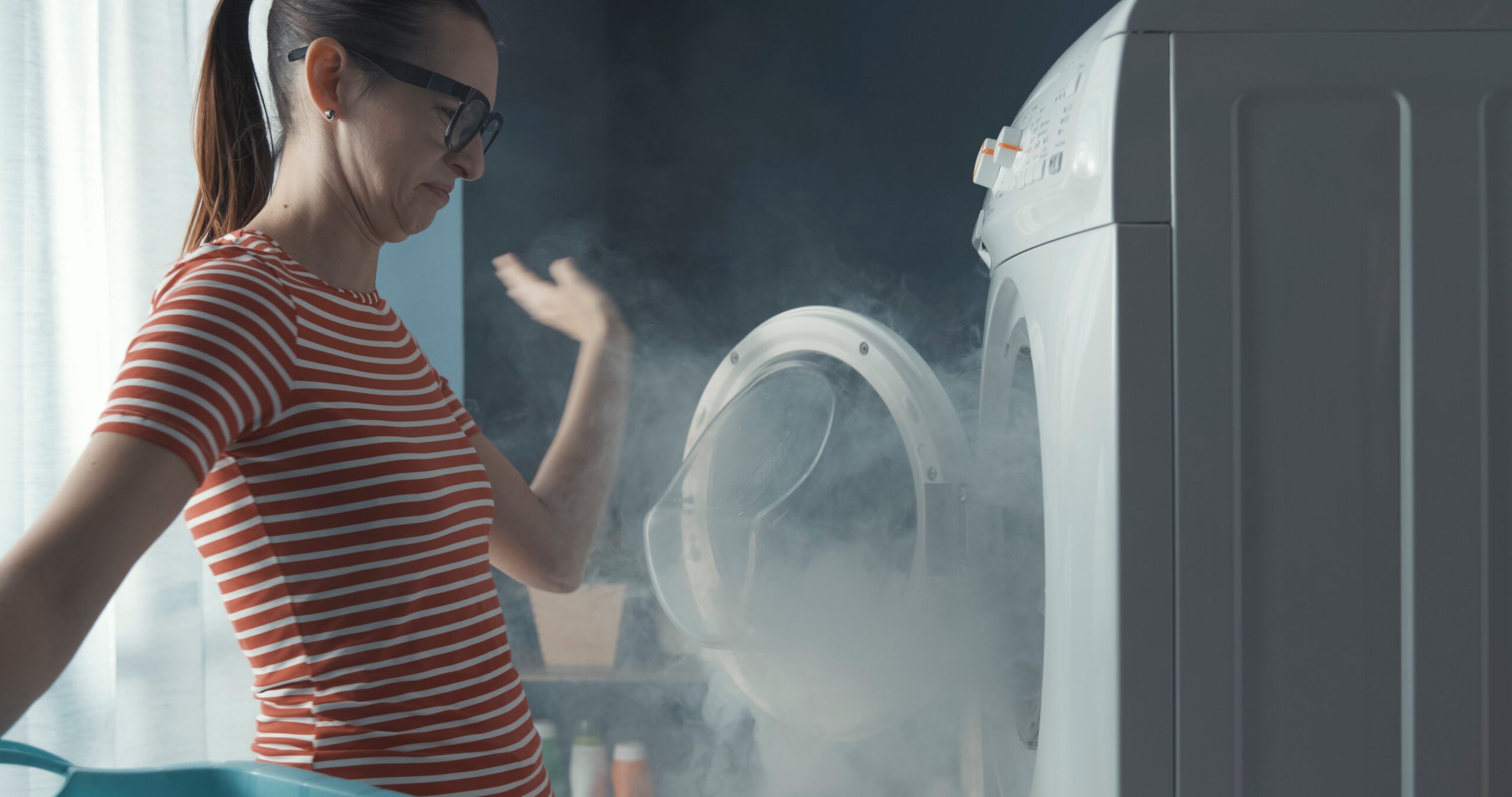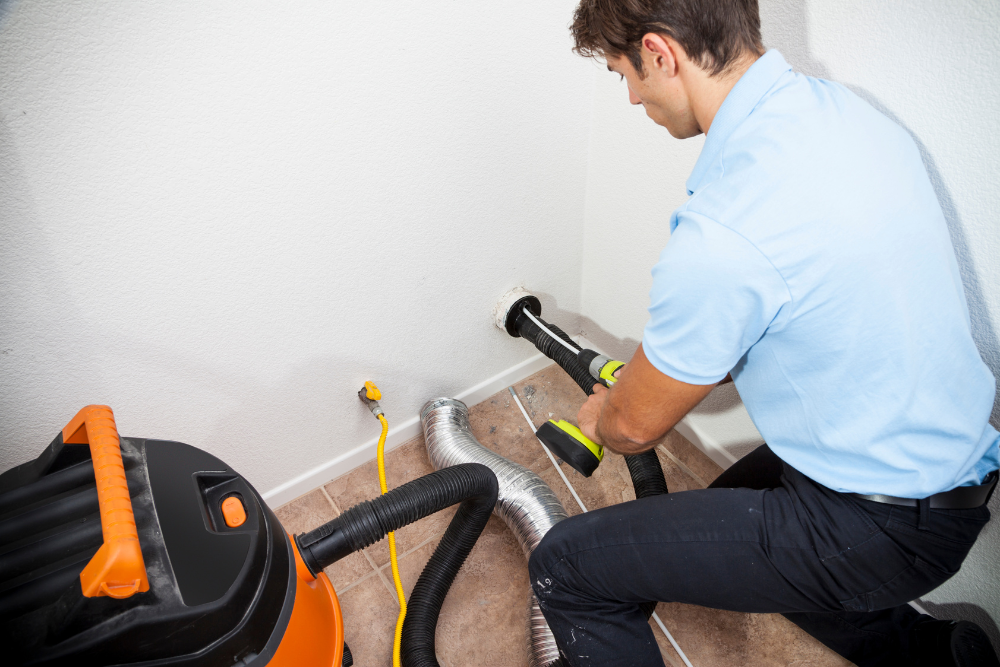Most of us rarely think about the dryer vent (duct) system in our homes. However, when dryer problems arise, we understandably focus on the appliance itself, unaware that the vent system may be contributing to or may be the major issue.
Cleaning or Replacement?
If a dryer problem is related to airflow rather than an electronic issue, it is often a venting issue and can be remedied by having both the dryer and the vent system cleaned professionally. Removing lint, hair, dust, and other debris from the dryer and vent can restore the appliance to its optimal efficiency. However, there are times when a thorough cleaning alone is not enough to bring the dryer back within the manufacturer’s specified tolerances.
Was Your Dryer Duct Installed Correctly?
Many of us have experienced, or know someone who has experienced issues following the purchase of a home. They discover that certain aspects of the house are not code compliant or were not installed using proper craftsmanship or materials.
This is often true with dryer duct systems. Many homeowners use their dryers for years without realizing that the machine is working much harder than necessary due to an underperforming venting system. This inefficiency can go unnoticed, especially when using Automatic or Sensor settings during drying cycles. These sensors automatically extend the drying cycle until they sense that the load is completely dry.
This adds time (which uses more energy, increases wear on parts, and reduces machine lifespan) with NO LINT obstructing the system and in new homes with brand new dryers. This vent system condition is frustrating, highlighting issues such as the failure of home inspectors, poor workmanship from appliance installers, miscalculations by architects, or subcontractors who installed the original system—many of whom may not fully understand dryer performance.
The Basics of a Dryer Vent System
Let’s talk about the basics of a dryer vent system.
Transition Vent vs. Dryer Duct
The term “vent” typically refers to the material that connects your dryer to the wall, floor, or ceiling inlet, while “duct” usually refers to the material that extends from the wall inlet to the outside wall or roof termination point. Although “vent” and “duct” are often used interchangeably, which can lead to confusion, both terms are used interchangeably.
Transition Vent Compliance
The material for the transition vent (which connects dryer to wall or ceiling inlet) should be 100% metal, and if made of a flexible material, should not compress to less than 4 inches. The most common material used by appliance installers is known as Mylar, a slinky-like plastic and foil material that compresses when the dryer is pushed back to the wall.
This material is not code compliant as it will compress to under 4-inches during installation. The maximum recommended length for a transition vent is 8 feet. Any compression in this section can significantly reduce airflow, which may negatively impact dryer performance.
It’s important to note that any inadequate component in the venting system may cause increased drying time without you noticing it, as described previously. Always check with your local building inspection department to determine local guidelines. Most will defer to your Dryer Installation Manual as the ultimate guideline.
Dryer Duct System Guidelines
According to the Uniform Mechanical Code (UMC), which serves as the basis for the Uniform Dwelling Code in many jurisdictions, a dryer exhaust duct must be constructed of rigid metal, such as galvanized steel. The minimum thickness required for the duct material is 0.020 inches (24-gauge). This specification ensures durability, fire resistance, and smooth airflow to prevent lint buildup and hazards. Note that some model codes (IRC or IMC) may allow a slightly thinner material at 0.0187 inches (26-gauge) for residential applications. Always verify with your local building inspection department to determine local guidelines.
Distance: The maximum length for a clothes dryer exhaust duct with is typically 35 feet from the dryer outlet to the termination point. If the dryer manufacturer specifies a shorter maximum duct length or sets stricter requirements, those specifications take precedence over the UMC’s general guideline.
Bends: This maximum length is reduced by the equivalent length of any fittings, such as elbows or bends. Each 90-degree elbow typically deducts 5 feet from the allowable length, while each 45-degree elbow deducts 2.5 feet. For example, two 90-degree elbows would reduce the maximum length by 10 feet, leaving 25 feet for straight ducting.
Exhaust Termination: The duct must terminate outside the building with a backdraft damper or vent hood, and the termination should not have a screen that could trap lint.
How to Test if Your Dryer Duct is Acceptable
Measuring duct performance is essential, as it is the only way to accurately evaluate how the dryer and duct system is functioning, whether new or old. Never hire an appliance professional or duct cleaner who advertises dryer vent cleaning unless they possess the appropriate tools to provide reliable measurements. Compromising on this can put your dryer’s safety at risk. In addition to pressure readings, qualified dryer service professionals can provide a before and after internal vent inspection using specialized camera and video equipment designed for dryer vent/duct systems.
Maytag and Whirlpool have consistently aligned their recommendations with industry standards for residential clothes dryer venting. They emphasize measuring static back pressure in the exhaust duct to ensure optimal performance, safety, and longevity. A Magnehelic gauge is used to measure the pressure drop or back pressure caused by restrictions in the duct system, such as excessive length, too many bends, lint buildup, or inefficient terminations.
According to their service guidelines and broader manufacturer recommendations, the maximum allowable static back pressure should not exceed 0.60 inches of water column (in. w.c.). This threshold is based on engineering tests and aligns with the International Mechanical Code or Uniform Mechanical Code, indirectly influencing venting specifications through airflow requirements.
In simpler terms: Reading exceeding 0.60 on the gauge indicate that your dryer is working much harder to operate. A reading of 0.60 is the threshold where the dryer and vent system may need cleaning, alteration, replacement, or rerouting. Readings of 0.40 or lower allow a dryer to operate for about two years between cleanings with a usage rate of 3 to 4 loads per week.
Reasons for the 0.60 in. W.C. Limit:
1. Efficient Airflow and Drying Performance
Dryers are designed to exhaust approximately 150-200 cubic feet per minute (CFM) of air at the blower outlet. A back pressure above 0.60 in. w.c. signifies significant restrictions that can reduce airflow by 20-30% or more. This leads to longer drying times (20-50% increase), uneven drying, and higher energy consumption, since the dryer must run longer to remove moisture.
Readings above 0.60 in. w.c. require immediate action, as they violate the manufacturer’s performance guidelines. Such measurements signal the need for duct cleaning, shortening, or reconfiguration. For consumer-level testing, Whirlpool and Maytag offer simple vent test kits for dryers with top top-mounted lint screens (e.g., W11224254), but Magnehelic testing is the gold standard for professionals.
2. Motor and Component Strain
The dryer’s blower motor is rated for a specific pressure range (typically 0.2-0.5 in. w.c. under ideal conditions). Exceeding 0.60 in. w.c. forces the machine to work harder, which can lead to overheating, premature wear, and potential failure. This strain can also affect heating elements, thermostats, and sensors, causing error codes to appear on the dryer’s electronic display.
3. Fire Safety and Lint Accumulation
Restricted airflow accelerates lint buildup inside the dryer and duct system. The 0.60 in. w.c. limit helps maintain a velocity of around 800-1,000 feet per minute, effectively carrying lint outdoors and reducing fire risks. Over 15,000 dryer-related fires occur annually.
4. Compliance with Design Specifications
Whirlpool and Maytag dryers are engineered with an expectation of a maximum equivalent duct length of 35-65 feet (depending on the model and fittings). This correlates with the .060 pressure threshold mentioned earlier.
This information is consistent with longstanding industry practices and aligns with Whirlpool and Maytag’s recommendations. However, always consult the specific model’s installation manual for any variances.
Wrapping it up
Dryer vent issues often go unnoticed but can reduce efficiency, extend drying times, and increase fire risks. Poorly installed ducts, due to excessive length, multiple bends, or improper materials, cause airflow restrictions, often masked by automatic dryer settings. Professional cleaning can help, but rerouting or replacement may be needed if the system fails to meet standards.
If you’re not sure whether your dryer vent system is correctly installed, clogged, or working like it should, or it’s been over a 2 years since you’ve had your system cleaned, contact Dryer Doctors using the form below. A family-owned business with over 60,000 happy service calls, we can help keep your dryer working better for longer.






